The latest of the online games is World of Warcraft. It has been an immense success with more than 1.5 million subscribers world wide. When examining the game, it is evident that its virtual world is exceptionally designed.
Intentional or not, many areas in the game are similar to the solutions found in the classical architectural work A Pattern Language by Christopher Alexander. This paper will explore these patterns and examine how they are applicable to MMORPG world design in general by doing a close study of the design in World of Warcraft.
The patterns described by Alexander are not only spatial construction blocks, but also intended to be used in creating a healthy society that enables social interactions. Therefore, many of these patterns should be useful in virtual worlds as well. Some of the patterns discussed in this study include Activity Nodes, High Places, Community Of 7000, Promenade, Country Fingers, Local Transport Areas, Neighborhood Boundary, Eccentric Nucleus, Sleeping in Public and Country Towns.
As an example, the pattern “Local Transport Areas” tells us that cars kill social interaction. Hence, local transportation should be done with bicycles, scooters or other means that stills enables a close interaction with the surrounding. Looking at World of Warcraft, we find that local transportation is either done by foot or using a mount. As used in the game, transportation is therefore not a means of moving between two places but rather a way to meet other players.
The aim of this paper is to create an improved understanding for the possible uses of architectural patterns in virtual world construction for digital games. It will show how some patterns are directly applicable, while others are useful in concept, and yet other fail to have any purpose.
Introduction
In the classical architectural work A Pattern Language, Christopher Alexander and his colleagues at the Center for Environmental Structures develop theories regarding the use of traditional architecture (Alexander et al. 1977). The book presents thought models and frameworks for creating healthy societies. Among other things, A Pattern Language focuses on creating environments which stimulates social interaction. Interestingly, a similar focus on social interaction can be found in massive multiplayer online role-playing games (MMORPGs). The aim of this paper is to show that many of the ideas presented in A Pattern Language are valid as tools and applicable when analyzing the virtual world of online gaming, and more specifically the game World of Warcraft (WoW) (Blizzard 2004). Intentional or not, many areas and locations in WoW are similar to the solutions found in A Pattern Language. This paper will therefore examine the game world design of World of Warcraft using the theories from A Pattern Language, and in this way try to understand which principles can be passed over from real world architecture to virtual world design.
Since its release in November 2004 World of Warcraft has grown to include more than two million paying subscribers world wide (Blizzard 2005). No other MMORPG has reached such popularity in an equally short time. Furthermore, WoW seems to attract more casual players than similar MMORPG games. This ability to attract a wide range of players makes it particularly interesting to study. In short, the player of WoW begins the game by creating a game character. The main goal is to develop the character from level one to the maximum level of sixty. Levels are gained by collecting experience points. The classical play-styles of achievement, socializing, exploring and player-killing dominate the game (Bartle 1996). For more information on WoW see the official online game guide (WorldOfWarcraft 2005) or any of the fan sites (WorldOfWar 2005) (Allakhazam 2005) (Thottbot 2005).
A Pattern Language presents 253 solutions, or patterns, for creating a well-formed environment. Each pattern explains a specific situation or problem, and furthermore discusses one or several guidelines in order to find a solution. The topics vary greatly, and cover most aspects of society, ranging from guidelines for building a 78. House for one person, to the importance of 103. Small Parking Lots. Each pattern is assigned a number and the same practice will be used in this text for simple referencing. A Pattern Language advices the reader not to apply any of the patterns separately. The core idea is to combine several selected patterns into a language. This architectural language can then be used to create an appropriate construction. However, the patterns are only guidelines and not exact layouts; the creative force of the designer is still needed to complete the process. The theoretical background to A Pattern Language is explained in detail in the accompanying volume The Timeless Way of Building (Alexander et al. 1979) and its practical application is discussed in the volume The Oregon Experiment (Alexander et al 1975).
Patterns and pattern languages are furthermore often discussed within the area of game studies and game design (Björk et al. 2003)(Björk and Holopainen 2005)(Kreimeier 2002). The patterns in the above mentioned papers are concerned mainly with the process of game design and primarily with the design of game structures. Some spatial elements for games are included as well, but never on the scale where the dynamics of whole cities or worlds are discussed. This is a gap that this paper takes into account and aims to study.
The strength of A Pattern Language emerges from its ability to generate very intuitive environments. It aims to create locations where people instantly feel at home, cities that aid navigation, and in general spaces that support natural human behaviour. As already mentioned, A Pattern Language is not about single patterns, but about the combination of several patterns which subsequently form a language. This paper will therefore analyse three different settings of World of Warcraft and describe the different patterns which are appropriate in relation to these locations. At first, the general world structure of WoW is studied, followed by a discussion of a particular region - The Barrens, and an analysis of the two major cities called Orgrimmar and Ironforge.
The World
The rules of the game world evidently differ from the real world and normal life. First of all, the players do not “live” in the game world. Most people log in for a couple of hours a day maximum. Consequently the game world needs more players than the real world to feel properly populated, since only a part of all players will be online at the same time. Another fundamental dissimilarity in the game world is the existence of non-location based chat channels, such as the region chat or the guild chat. This enables players to communicate in the game even though they might not be at the same location. In fact, space and travelling speed are nothing but arbitrary limitations imposed by the rules of the game. However, the game does its best to enforce these rules and space has far from lost its meaning even in this virtual world.
The world in World of Warcraft has been divided into two continents. Each continent is then further divided into several regions with a number of towns and cities. How is such a world designed so that it supports all the aspect discussed earlier? A potential language for the design of the world in WoW would include the patterns 1. Independent regions, 2. The distribution of towns, 12. Community of 7000, and 28. Eccentric Nucleus from A Pattern Language. Although this is not a complete language it does however include some of the most important characteristics.
[Figure 1: Screenshot of the two continents]
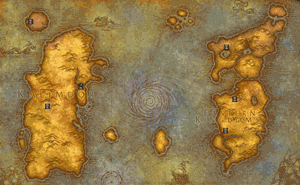
The pattern 1.Independent regions describes how the maximum size of each independent region should not include more than 10 million inhabitants (Alexander et al 1977, 10). Since the total amount of players in World of Warcraft is much smaller than this partitioning, it has no purpose. However, future games might want to look into the difficulty of having more than 10 million players in one community, and the problems which arise in such a scenario. Furthermore, even though the total number of players in WoW exceeds 2 million, the next pattern discusses a much more important limit in the game.
Pattern 12. Community Of 7000 states that “Individuals have no effective voice in any community of more than 5,000 – 10,000 persons” (Alexander et al. 1977, 71). Interesting enough this corresponds closely to the size of a realm. A realm, or a server, is an instance of the game, and players cannot move to or communicate with players on other realms. A realm has a total population of about 10,000-12,000 players (Warcraft Realms 2005), divided into the two factions Alliance and Horde. Players from the two factions can not communicate with each other in the game except through visual emotes, such as “wave”, “goodbye”. This gives the single player a community of about 5000-6000 players with whom he can interact verbally within the game. This limit enables the players to be able to make a significant impression in the community, whereas if all players were on the same realm, they might feel lost. In conclusion, the server limit is not only an arbitrary technical limit, but also fits well with the suitable community size suggested in this pattern.
Several guidelines regarding cities or larger towns are offered in pattern 2.The distribution of towns. Most importantly towns of different sizes should be distributed evenly across an area. For example, an area could consist of one city inhabited by 1,000,000 people, 10 towns with 100,000, 100 with 1000 inhabitants, and so on. The placement of these cities should be done in such a way that the cities of the same size are homogeneously spread out in a region. The purpose of this is to balance the access a person has to both smaller and larger cities from any point in the world (Alexander et al. 1977, 19). Figure two and three show illustrations of the distribution of cities in the game. The placement and distribution of towns and cities in WoW adhere to the pattern very closely.
[Figure 2: Distribution of towns on Kalimdor]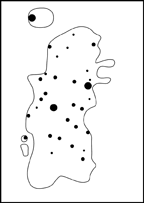
|
[Figure 3: Distribution of towns on Eastern Kingdoms]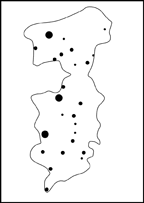
|
As players move through the world, they will want and need to move towards the larger cities in the world. This is a natural process that can be observed both in the real world and in the game. The pattern 28. Eccentric Nucleus explains the necessity to place major cities on the edge of a zone, not in the centre. Furthermore, local centres should be created in the direction of the main centre in the world. This will allow people to naturally pass through this point, and thus enhancing the activity of the local centres (Alexander et al. 1977, 150). It will also help players to orientate in the world as they travel through it the first time, making the local centres natural checkpoints on the way to the main city. Figure four and five show illustrations of the world in World of Warcraft with region borders, local centres and major cities marked.
[Figure 4: Illustration of city placement on Kalimdor]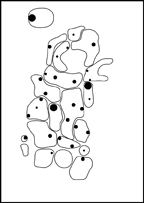
|
[Figure 5: Illustration of city placement on Eastern Kingdoms] 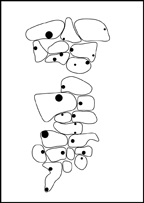
|
In conclusion, these three patterns guide the designer on how to partition the world and provide an understanding of the size and number of cities as well as their general placement within the world.
The Region
The second sub language I have chosen to focus on is a language that can be used within a region of the game world. One of the more interesting regions in the game from the Horde perspective is The Barrens. This is one of the busiest areas outside of the major cities. The patterns included in this section are 3. Country Fingers, 5. Lace of country streets, 6. Country Towns, 11. Local Transport Areas. The pattern 28. Eccentric Nucleus presented in the previous section is also closely connected to the design of the regions and is a good example of how the patterns are interconnected.
The players in World of Warcraft need to be close to their questing areas, and at the same time not be far away from the main city and the services that are provided there. Otherwise too much time will be spent on travelling. Pattern 3. Country Fingers discuss a similar dilemma. Many people experience the need to be close to the country side and at the same time have access to the density available in a city (Alexander et al. 1977, 22). The proposed solution is to create interlocking fingers of farmland and urban land. The urban fingers should never be more than 1 mile wide, while the farmland fingers should never be less than 1 mile wide. While this is not directly implemented in a region like The Barrens, it does have some relevance and could perhaps have been more strongly enforced. The roads in The Barrens create a certain urban density since this is where most people choose to travel and use as means of orientation. The areas that the roads encircle are the different quest areas. Although there are some quest points along these roads, most of the quests are picked up in the main village Crossroads. However, removing these quest points from Crossroads would probably not be a good solution, since it would make the village appear empty.
Pattern 3. Country Fingers is tightly connected to pattern 5. Lace of country streets. The key issue in pattern five is to avoid the creation of suburbs. The suburb is a place that has all the negative aspects of the big city and the country side but none of the positive (Alexander et al. 1977, 30). The solution is to arrange country roads around large open squares of countryside and build houses along the roads, but only one house deep. In this way people would live close to the countryside but still be on the main road to the big city. According to these guidelines, there could be more buildings placed along the roads in The Barrens. However, since there are only a limited number of services that the players need, this would only create many unused and empty buildings. Figure six illustrates this pattern with an overview of the roads, key areas, mountains and villages in The Barrens.
[Figure 6: Illustration of roads, mountains and villages
in The Barrens]
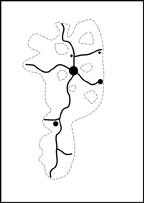
Small towns need to have a vital local business to stay alive and be active. This is the essence of pattern 6. Country Towns (Alexander et al. 1977, 34). The same goes for the smaller villages in the game world. Although the NPCs might not move away, no player would ever visit a town he knows is empty, or at least not remain there longer than necessary. The most frequent services a player need to access in the game include repairs of equipment and sales of ammunition, drinks and food. Furthermore, these services are usually accessed at the same moment in the game, during pauses in questing. The village Crossroads in The Barrens is one of the most vibrant smaller towns in the game on the Horde side. This is without doubt the result of providing the players in this region with all the services they need, as well as fast communications with the main city. It works as a pickup place for quest and also as a social interaction point. Lots of lower level players are hanging out here in the square, chatting, comparing equipment or duelling.
[Figure 7: Players hanging out in Crossroads]
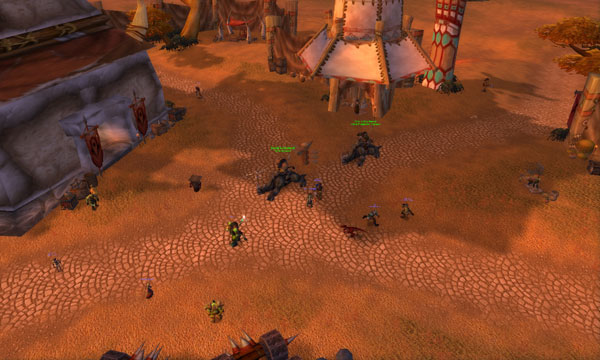
Finally, the pattern 11. Local Transport Areas advises us that cars kill social interaction. Hence, local transportation should be done with bicycles, scooters or other means that stills enables a close interaction with the surrounding (Alexander et al. 1977, 67). Looking at the game, we find that local transportation is either done by foot or using a mount. As used in the game, transportation is therefore not a means of moving between two places but rather a way to meet other players. The roads as such act as attraction points in the game, and create a certain density of players around them, enough for the world to feel alive. The potential for casual encounters is big when traveling along the road and it is common knowledge in the game to try to avoid the roads in enemy territory if you are not seeking to engage in combat.
[Figure 8: Casual meeting in enemy territory]
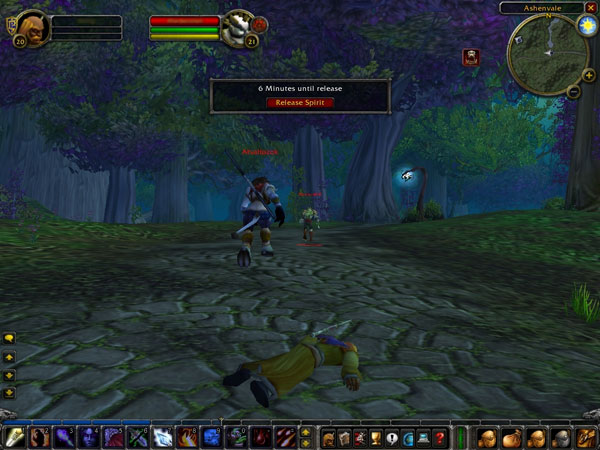
The Big City
The last scenario discussed in this paper is the big city. This is also the focus of a majority of the patterns in A Pattern Language. The two big cities in the game, Orgrimmar and Ironforge, are the main centers for each of the two factions. This is where all high level trade and pickup quest groups are formed. They are both busy places with lots of different services, with the most important being the Auction House, the Bank, the Mailbox and the Inn. The city furthermore contains many of the trainers and sales points that are needed for trade skills such as tailoring, or for learning new class abilities (spells, weapon skills, etc).
The placement of the facilities in a city must be done with great care. Scattering services individually through the city does not enhance activity (Alexander et al. 1977, 164). Pattern 30. Activity Nodes instead tells us to gather the services mostly used together. The triangle created by the Auction House, the Bank and the Mailbox in Orgrimmar and Ironforge are prime examples. The mailbox is important because this is where items bought in the Auction House are delivered. The area within this triangle is the very focal point of activity in both cities. The placement of this activity triangle within the cities can be shown in figure nine and ten. Figure eleven and twelve show the density of players in this area on a normal day. Interestingly enough, only a few meters away there is almost no activity at all as can be seen to the left in figure 12. It has been indicated that the use of activity nodes is in fact a conscious design decision in World of Warcraft (Judgehype 2005).
[Figure 9: The activity node area in Orgrimmar]
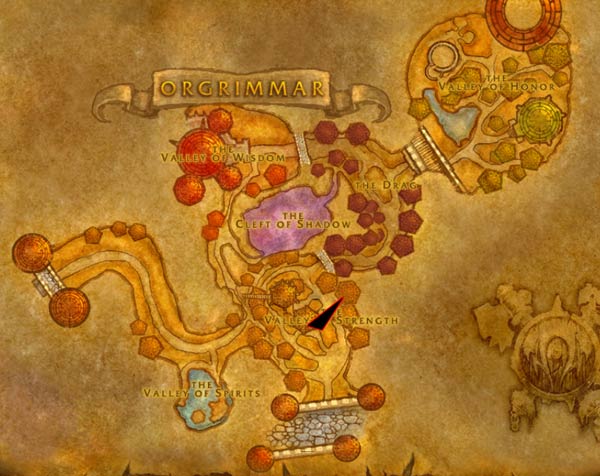
[Figure 10: The activity node area in Ironforge]

[Figure 11: Screenshot from Orgrimmar. The Bank is to the left, the Mailbox
behind all the players in the centre, and the Auction House up the hill
to the right.]

[Figure 12: Screenshot from Ironforge. Facing the Bank, the Auction House
is behind us. The Mailbox is to the right of the Bank.]

A neighborhood without a boundary is a week neighborhood. It will not be able to maintain its own identifiable character (Alexander et al. 1977, 87). The pattern 15. Neighborhood Boundary discusses the importance of zone boundaries in a city, enabling each community to access most of the things they need within a small area. In terms of city planning this pattern has been implemented in both Orgrimmar and Ironforge. Both cities are divided into zones, mostly one area for each class with the most usual profession services needed within that small neighborhood. This placement makes it easier for the beginner of the game to orient themselves and minimize the time spent searching through the city. In practice the pattern is implemented by enforcing the borders and limiting the number of entry points into an area. These entry points can then be further emphasized by creating a gateway or portal as described in 112. Entrance transition and 53 Main Gateways (Alexander et al. 1977, 549, 277). An entrance transition enables the player to understand that he is moving into a different area of the city. These types of gateways are particularly present in Orgrimmar, see figure 15.
[Figure 13: Overview of Orgrimmar with boundaries marked]

[Figure 14: Overview of Ironforge with boundaries marked]

[Figure 15: Gateway in Orgrimmar]

Social interaction in World of Warcraft is supported by the way equipment is selected. Getting the best equipment is a considerable part of World of Warcraft. However, to do this the player need to know what equipment to get, and the best feature to do this inside the game is to inspect other players’ equipment. The inspect ability only works on a very short distance so a player needs to get very close to another player to be able to do this. This behaviour opens up opportunities to discuss with other players where they found a certain piece of equipment. The pattern 100. Pedestrian street discusses the importance of making a street narrow enough so that people are forced to move really close and thus increase the shoulder rubbing that takes place there. This type of interaction is assumed to be an essential type of social “glue” in any community (Alexander et al. 1977, 489). On the other hand a narrow street is not everything. The pattern 121. Path Shape for instance explains the use of a bulge on a street to make people slow down and spend a bit more of time in this area while passing through (Alexander et al. 1977, 591). Evidently, this can be seen in Orgrimmar as the area just between the main entrance and the activity triangle.
[Figure 16: Inspect feature. “Where did he get
this thing?”]
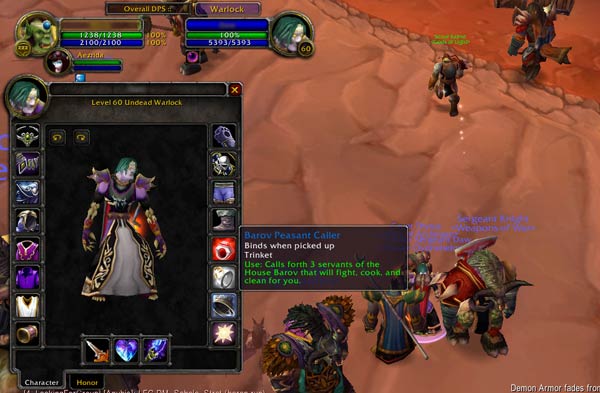
Furthermore, it does not matter how narrow or wide a street is if there are no people there. Pattern 123. Pedestrian density explains that an area is considered as lively when there is approximately 150 sq feet per person (Alexander et al. 1977, 598). The scale of the game world works a bit differently than in the real world. Players can pass through each other without collision, making it difficult to transfer pattern 123. Pedestrian Density exactly to the game world. However, it remains a valid remark since when a place gets crowded, it generates a positive feedback loop that attracts more people to this location.
A promenade is a place where you go to see people, and to be seen. Attracting people to the promenade is discussed in 31. Promenade. It is stipulated that the people who live less than 20 minutes away will use a promenade. People who live more far away tend usually not to use a promenade (Alexander et al. 1977, 170). Since no one is actually living in World of Warcraft, this translates badly into the game world. We could however consider the Inn (see figure 17) as the home location for all the players that have their hearthstones bound to this location. The hearthstone is a feature in the game that enables you to teleport home to a location you have previously visited. The hearthstone can only be bound to one location at a time. Most players end their play sessions by teleporting back to the home location. This means that the Inn will also be the starting location of their next play session. A small informal questionnaire carried out inside the game indicates that most high level players have their hearthstones bound to the Inns in Orgrimmar or Ironforge. Thus it is essential that the promenade is placed close to the Inn of the major cities. The promenade in Orgrimmar is in effect the very short distance between the Auction House and the Mailbox. Although it is important to keep these two services together this area sometime gets a bit too crowded, and could perhaps have been stretched out a bit more as has been done in Ironforge.
[Figure 17: The Inn of Orgrimmar]
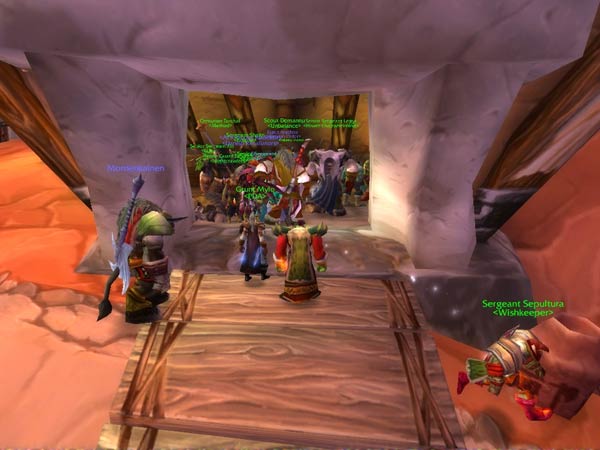
[Figure 18: The overcrowded promenade in Orgrimmar]
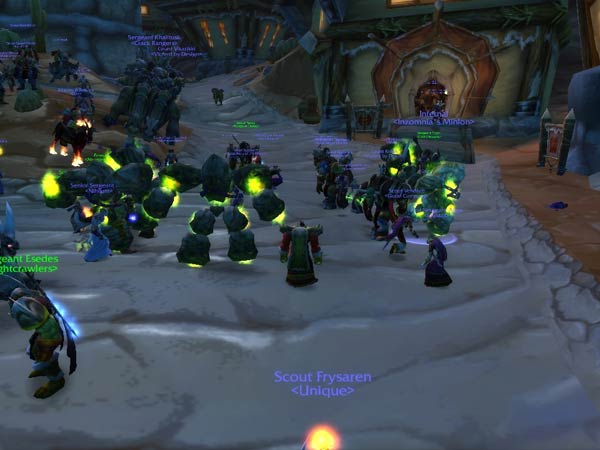
[Figure 19: Promenade in Ironforge]
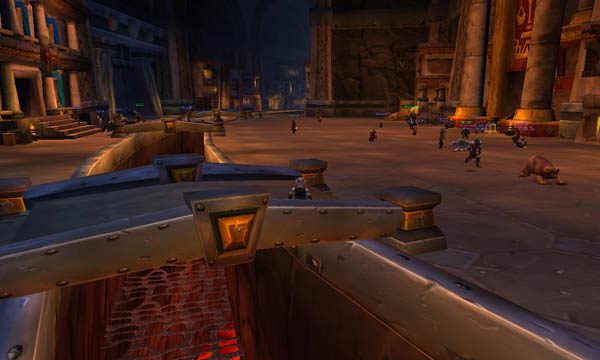
It has been argued that vertigo is one of the foundations of play (Caillois 1961). The pattern 62. High Places ponders the significance of creating these high locations; “The instinct to climb to some high place, from which you can look down and survey your world, seems to be a fundamental human instinct” (Alexander et al. 1977, 316). High buildings give people a place that they can use to orient themselves toward, when they are on the ground. It is however, equally important as places from where to look down. The pattern furthermore explains that these high places should be spread out in the city with great care so that each can serve as a distinct landmark for its part of the city. Many of these settings are found in World of Warcraft. In Orgrimmar the most important are perhaps the flight tower, but even the roof of the bank that can be accessed from ground level on one side fills the same purpose. A location outside of the cities worth mentioning is the entire area of Thousand Needles.
Furthermore, the top of the bank in Orgrimmar is related to pattern 94. Sleeping in Public. This pattern argues that it is “a mark of success in a park, public lobby or a porch, when people can come there and fall asleep” (Alexander et al. 1977, 458). Players in the game tend to place their avatars in certain places when they know they will be away from keyboard for a while and the top of the bank is one of these places. According to the guidelines in the pattern these places should be made “relatively sheltered, protected from circulation, perhaps up a step, with seats and grass to slump down upon” (Alexander et al. 1977, 459). Some of these aspects are definitely missing, and could probably further enhance the game world if they were implemented.
[Figure 20: Top of bank, Orgrimmar]
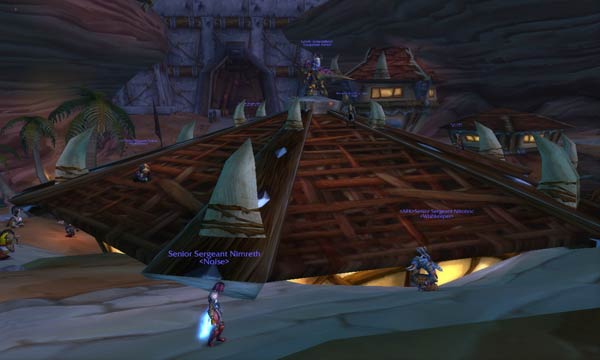
[Figure 21: Thousand Needles]
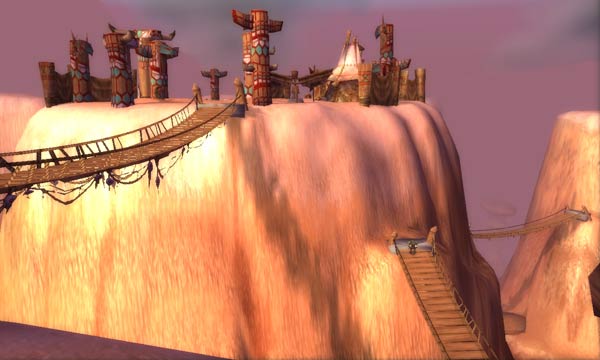
Navigation through a big city can be confusing to say
the least. There are several patterns in A Pattern Language that
try to reduce this problem. Pattern 120.Paths and goals stresses
the importance to consider how humans behave as they walk through a city
or landscape. People constantly scan the environment for intermediate
destinations, and focus on the furthest visible point along the path.
They will then try to walk more or less in a straight line toward this
point. As new points are discovered these will become the centre of attention
(Alexander et al. 1977, 587). This process is illustrated in figure 22
from A Pattern Language. Furthermore, the pattern provides the
following design guidelines; place goals at natural points of interest,
then connect the goals to one another to form the paths. The paths may
be straight or gently curving between goals. As for the game world, this
pattern can be observed in two different ways in Orgrimmar and Ironforge.
Whereas Ironforge is very symmetrical in its layout, Orgrimmar has a much
more organic style. In both cases it is possible to see how goal points
have been placed at crucial positions as to help the navigation through
the city. Figure 19 shows a characteristic example from Orgrimmar where
the light in the distance serves as an attraction point.
[Figure 22: Illustration from A Pattern Language, p. 587]
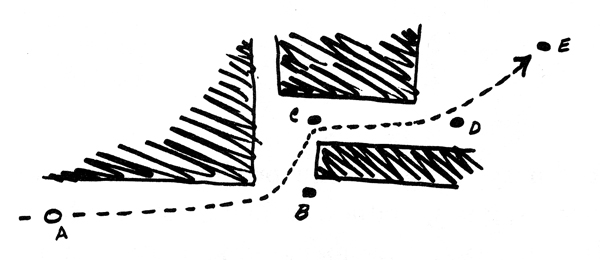
[Figure 23: Orgrimmar. The fire in the distance serve as an attraction
point.]
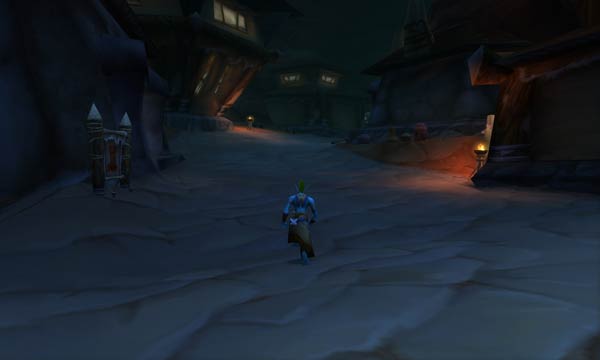
Playing a MMOG unfortunately involves spending a lot of time in the game waiting. In World of Warcraft in particular players tend to wait for quest groups to form or for enough players to enter the battlegrounds for these to start. Waiting is the theme of pattern 150. A place to wait. It is suggested that the process of waiting has inherent conflicts, and it is necessary to creating situations that makes waiting positive (Alexander et al. 1977, 708). The most obvious locations where players wait are outside the battleground entrances. Interestingly enough the players tend to duel each other outside of these locations. However this is also the only activity provided to the players as they wait there. Creating spaces that offers more opportunities for free play in this area might reduce the amount of complaints the battleground queue system receives (World of Warcraft Europe 2005). Anyone who spent some time outside the Warsong Gulch knows that the players there are highly frustrated. Other locations worth mentioning are the Zeppelin platform and the Deep Run Tram stations. They both serve to increase the number of casual encounters a player makes in the game, although the Zeppelin platforms seems to serve this purpose better by providing a much smaller and denser waiting area.
[Figure 24: Waiting outside Warsong Gulch]
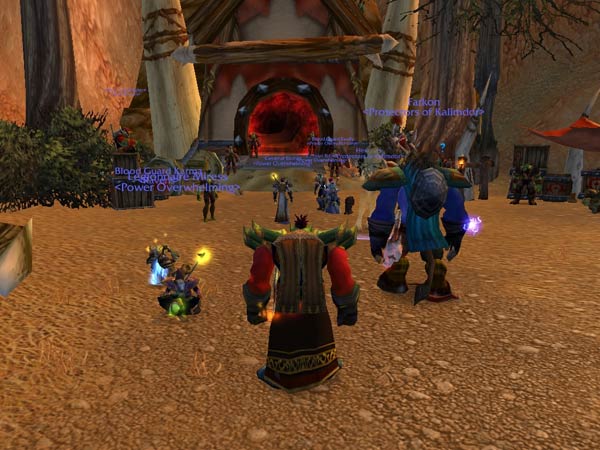
[Figure 25: Zeppelin Platform]
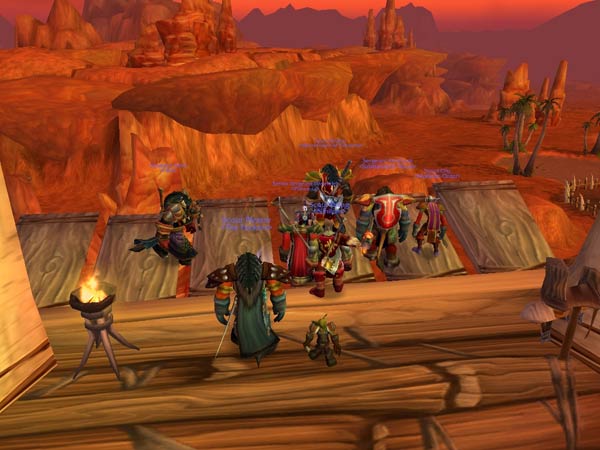
[Figure 26: Deep Run Tram Station]
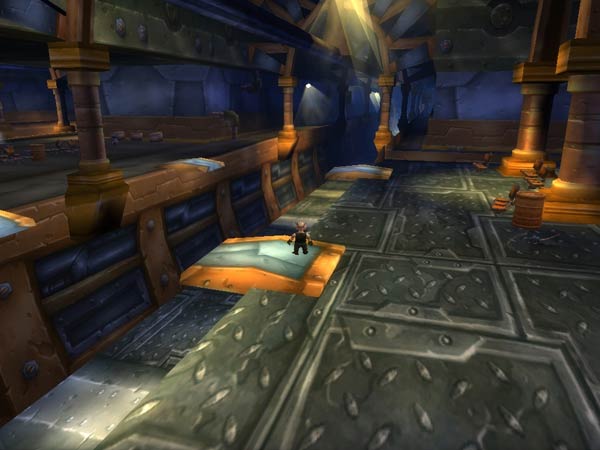
Finally, let’s look at a pattern that does not seem to work at all in the game. Pattern 181. The Fire states that “There is no substitute for fire” and further explains that the fireplace is a powerful focus point for social interaction (Alexander et al. 1977, 839). Although there are several big fireplaces in Orgrimmar, none of them seems to function as a social meeting place. However, this might be due to the fact that they do not provide any actual functionality in the game and as mere decorations their attraction is not strong enough.
Conclusions
The purpose of this paper has been to present some thoughts on applying the patterns from A Pattern Language in virtual game worlds. Three example languages have been examined in the context of World of Warcraft; however it should not be difficult to transfer the concepts to other similar games.
This paper furthermore strives to give hints on how to create a game world that is intuitive and where casual players can feel at home and navigate without too much difficulty. It is recommend that anyone interested in creating or analysing virtual game worlds read and apply some of the ideas from A Pattern Language.
References
Alexander, Christopher et al. 1977. A Pattern Language - Towns Buildings Construction. New York: Oxford University Press
Alexander, Christopher et al. 1979. The Timeless Way of Building. New York: Oxford University Press
Alexander, Christopher et al. 1975. The Oregon Experiment. New York: Oxford University Press
Allakhazam. 2005. Allakhazam.com: World of Warcraft. http://wow.allakhazam.com/
Bartle, Richard. 1996. “HEARTS, CLUBS, DIAMONDS, SPADES: PLAYERS WHO SUIT MUDS.” http://www.mud.co.uk/richard/hcds.htm
Björk, Staffan and Holopainen, Jussi 2005. Patterns in Game Design. Hingham: Massachusetts: Charles River Media, Inc.
Björk, Staffan, Sus Lundgren and Jussi Holopainen. 2003. Game Design Patterns. In Level Up: Digital Games Research Conference. ed. Marinka Copier and Joost Raessens. Utrecht, The Netherlands: Utrecht University.
Blizzard. 2004. World of Warcraft. Blizzard Enterteinment.
Blizzard. 2005. “World of Warcraft® ACHIEVES NEW MILESTONE WITH TWO MILLION PAYING SUBSCRIBERS WORLDWIDE”. Blizzard Entertainment. http://www.blizzard.com/press/050614-2million.shtml
Caillois, Roger. 1961. Man, play and games. Urbana: Chicago: University of illinois Press.
Judgehype. 2005. “Blizzard interview by JudgeHype”. Judgehype World of Warcraft. http://worldofwarcraft.judgehype.com/index.php?page=interviews23-en
Kreimeier, Bernd. 2002. “The Case for Game Design Patterns”. Gamasutra. http://www.gamasutra.com/features/20020313/kreimeier_01.htm
Thottbot. 2005. Thottbot: World of Warcraft database. http://thottbot.com/
Warcraft Realms. 2005. WarcraftRealms.com. http://www.warcraftrealms.com/
WorldOfWar. 2005. The Unofficial World of Warcraft Site. http://www.worldofwar.net/
WorldOfWarcraft. 2005. World of Warcraft Game Guide. http://www.worldofwarcraft.com/info/basics/
World of Warcraft Europe. 2005. “A Few Notes on Battleground Wait Times “. PvP Forum. 2005. http://forums-en.wow-europe.com/thread.aspx?fn=wow-pvp-en&t=72991&p=1&tmp=1#post72991